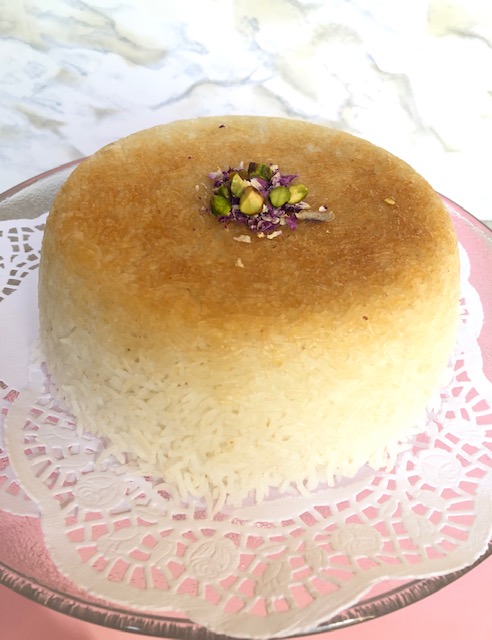
Iranians take their rice very seriously! It has to be high-quality long-grain, Basmati rice. When prepared correctly Persian rice is aromatic, flavorful, and fluffy. The grains are easily separated with a fork – never sticky. Rice is the cornerstone of every Iranian meal. Today’s recipe is for how to prepare fool-proof Persian rice in a rice cooker.
Over the years I’ve learned to be a pro at the rice cooker method and you can be too! Even my Bob knows how to get the rice going using a rice cooker and if he can do it anyone can ;).
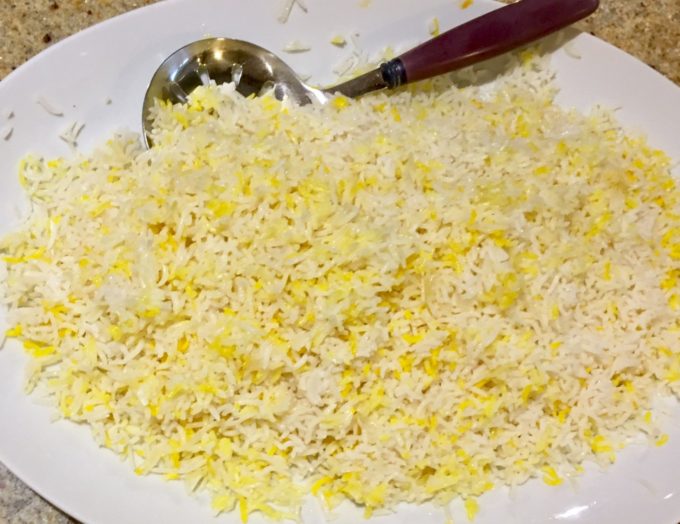
Persian rice is often served with a flat spoon or spatula to delicately handle the soft, cooked grains.
A traditional method for holding the steam in the pot is to place a dish towel or paper towel right under the lid. This keeps the steam and the moisture from escaping while the rice is cooking.
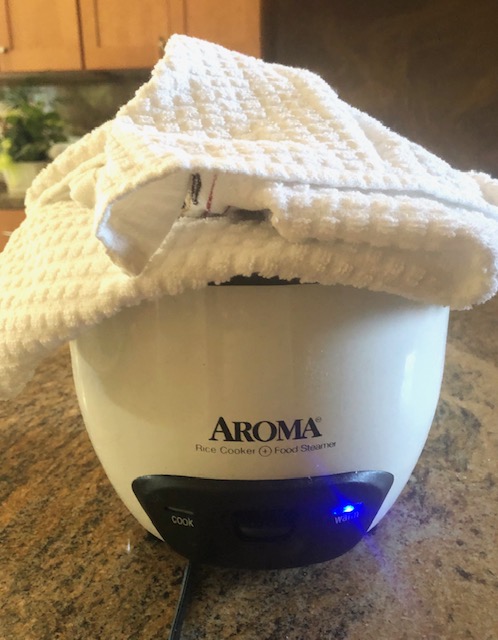
This is our smaller, 3 cup size rice cooker with a dish towel under the lid. Here is a link to order a 3 Cup size Aroma brand rice cooker.
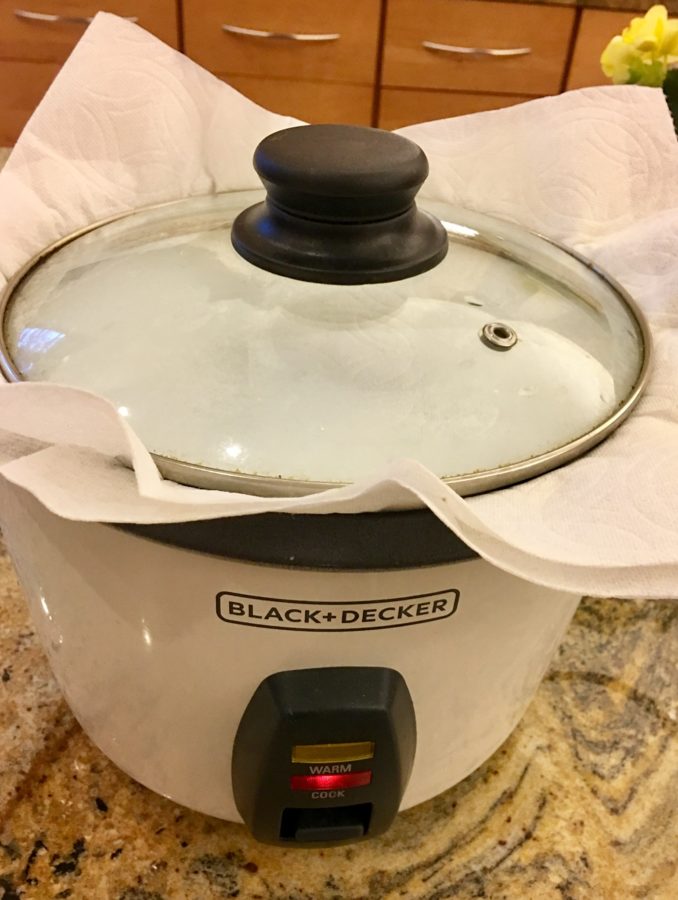
This is our old 6 Cup rice cooker with a paper towel holding the steam in. Here is a link to order an Aroma brand, 6 Cup rice cooker.
On a nutritional side note, our family has cut down on rice consumption significantly over the years. A fist of rice is about one portion. To measure one portion of rice, ball your hand into a fist and get a visual of how much to put on your plate. This amount is a far cry from the mounding platefuls of the past!
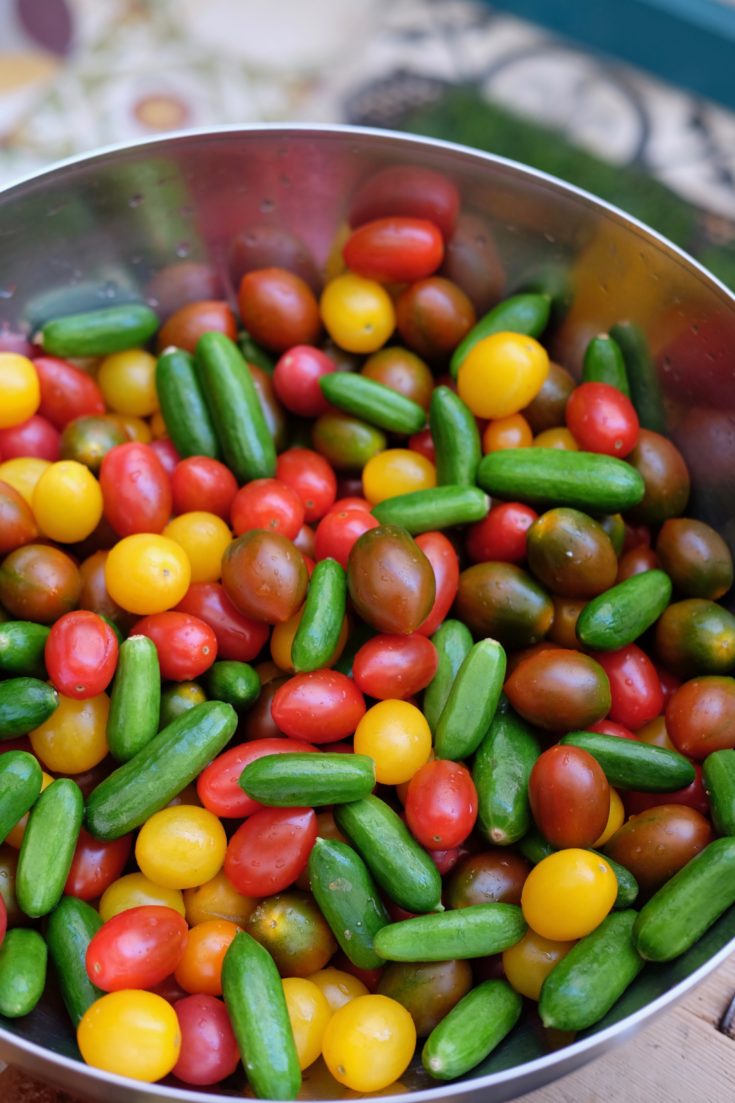
tradition Persian salad (salad shirazi) simply consists of Persian cucumbers, tomatoes, fresh mint, onion with a splash of lemon juice and salt.
In Persian kabab restaurants, a heaping plateful of rice is served in front of each individual. Our healthy strategy in Persian restaurants is to order our meal with “half rice, half salad”. Many people order this way now (the wait staff is very familiar with the half rice order) as we all start to move towards a more plant-based, fresh food diet. Also recently we downsized to a smaller, 3 cup size rice cooker.
Tips for Preparing Persian Rice in a Rice Cooker:
- start with high-quality long-grain Basmati rice
- rinse the rice several times (4 or 5 times) with water in a colander until the water rinses out clear
- then soak the rice in water before cooking (for 30 minutes to 2 hours)
- use a towel (cloth or paper) to hold in the steam under the lid of the pot
- use Persian saffron when possible (optional)
Worth noting that the bottom of the pot of rice is considered a delicacy in Persian food. Since the Farsi language uses a different alphabet (Arabic letters), there are many ways to spell the word for this crispy (slightly burned) rice in English. “Tah” means ‘bottom’ while ‘deegh’/’digh’ means ‘the pot’. Tahdig literally means the bottom of the pot (…of rice is implied). It’s often saved for someone special in the family – the quantity of tahdig is limited to the surface area of the bottom of the cooking dish! In addition to the slightly burned, crispy rice, we also have a couple of other types of tahdig often cooked at the bottom of the pot – potato and bread (lavash). Take a look at my full post on Persian tahdig.
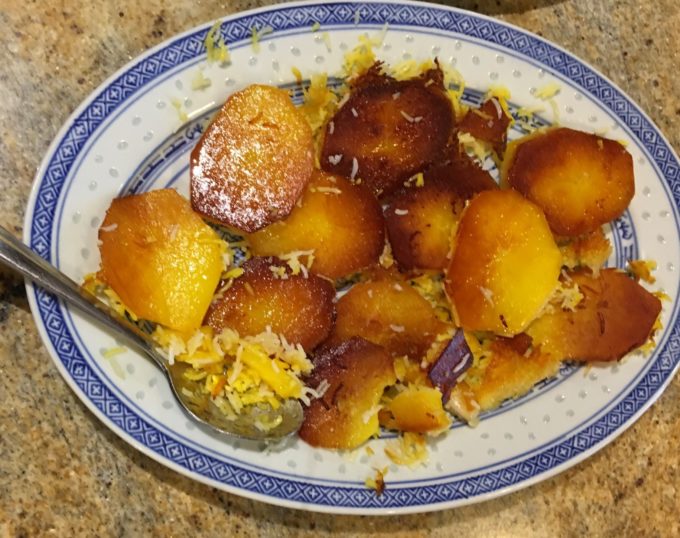
This is a yummy, crispy potato version of tahdig served at my in-law’s house. Add salt and it tastes like French fries!
To make rice with the yummy bottom crispy rice crust, drain and rinse the rice after steaming, add extra cooking oil to the bottom of the rice cooker pot, transfer the rice back in, and cook, pressing high on the rice cooker a couple of extra times. The extra oil helps to get the bottom crispy without burning. You may need to also increase the cooking time and experiment to get the perfect crispy bottom.
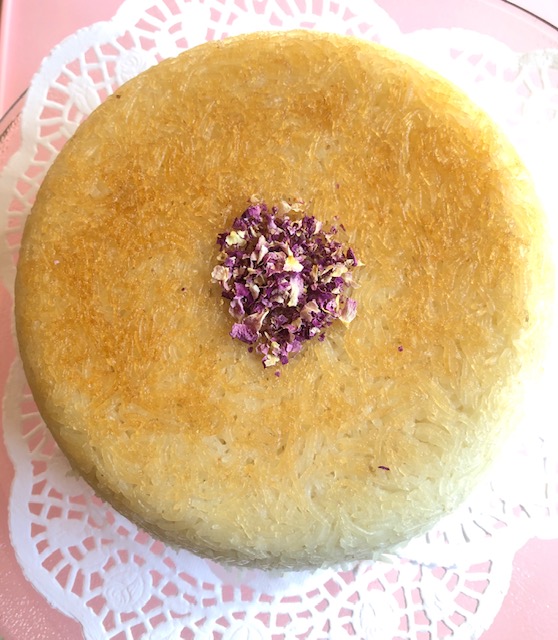
Top view of a nicely cooked Tadigh (crispy bottom of the pot of rice) molded right in the rice cooker. Decorated here with dried culinary rose petals.
How do you get a perfect rice tahdig using a rice cooker?
- After the allotted time and a bit extra to get a golden crust, remove the lid and the towel from the rice cooker.
- Using oven mitts or dish towels to protect your hands take the inner pot out of the rice cooker.
- Place a large serving plate over the top of the rice cooker.
- Carefully flip the pot over like a jello mold or bundt pan until the rice cake falls out.
- Lift the pot off to reveal the beautiful molded rice!
When we’re talking about rice we have to also talk about saffron. Saffron is the king of spices in Persian cooking! Saffron is sometimes used when steaming rice in a rice cooker, however adding it is optional. The yellow color or specks on the rice you sometimes see Persian rice is from saffron. Saffron is very aromatic and takes rice to the next level, bringing out all the flavors. The best saffron comes from Iran which can be tricky to get ahold of. If you can’t get Persian saffron from a middle eastern market. You can also order it on Amazon.
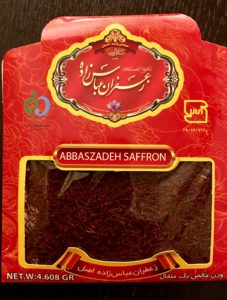
saffron, spice, spices, spicey
Even easier than dissolving dried saffron is using the pure saffron spray. It’s concentrated and gives off a vibrant color as well as an authentic, delicious flavor. To order some Pure Saffron Spray online click HERE.
Side dishes that pair well with Persian rice:
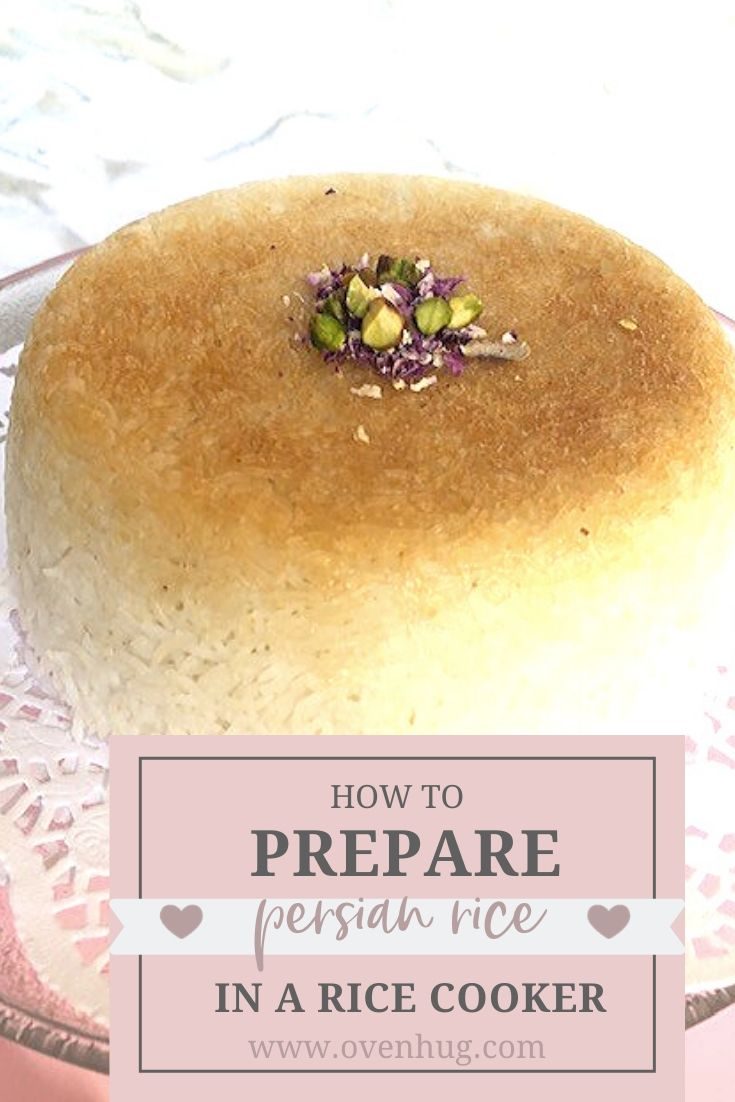
Add protein and make this a meal by cooking delicious and Easy Marinated Salmon to enjoy with your rice or enjoy with a luscious and iconic Persian stew Khoresh Fesenjan | Persian Pomegranate Chicken!
How to Prepare Persian Rice in a Rice Cooker

Iranians take their rice very seriously! It has to be high-quality long-grain, Basmati rice. When prepared correctly Persian rice is fluffy and the grains can be separated with a fork. The Farsi word for rice is polo. Polo is a staple in Iranian cuisine. Follow this simple recipe to make a perfect rice every time.
Ingredients
- 3 cups basmati rice
- 4 cups water
- 1½ teaspoons finely ground saffron dissolved in 2 Tablespoons hot water
- ¼ cup of canola oil
- 1 teaspoon salt
Instructions
- Rinse the rice several times (4 or 5 rinses) until the water runs off clear
- Soak the water for a minimum of 1 hour in water
- Pour off the soaked water
- Put the rice in the rice cooker
- Add the 4 cups of fresh water
- Add oil, salt, and dissolved saffron
- Allow the water in the rice cooker to come to a boil (usually takes 10 to 15 minutes in most rice cookers)
- When the water is almost completely boiled off, drape a paper towel or cloth over the top of the rice cooker and place the lid tightly in place to keep the moisture in during steaming
- Cook on high for about 30 more minutes
Notes
*Dry grains of rice tend to triple in size when cooked. The recipe above for a standard-sized rice cooker is for 3 cups of uncooked rice - this produces about 6 cups of cooked rice.
Today's rice cookers mostly have automatic heat settings. When you press the rice cooker on it will normally start on high, get the rice to boiling, go through the cooking/steaming stage, then switch itself to a 'warming' mode on its own. Usually, you push down on the lever to start the rice cooker and it clicks up when it converts to the 'warming' setting. If you are going for the crispy crust I recommend you manually press down on the lever a 2nd time after it pops up to increase the higher cooking level for a longer amount of time. Experiment with the timing until you get the desired results.
- start with a high-quality long-grain rice
- rinse the rice several times (4 or 5 times) with water in a colander until the water rinses out clear
- then soak the rice in water before cooking (for 30 minutes to 2 hours)
- use a towel (cloth or paper) to hold in the steam under the lid of the pot
- after the allotted time and a bit extra to get a golden crust, remove the lid and the towel from the rice cooker
- using oven mitts or dish towels to protect your hands take the inner pot out of the rice cooker
- place a large serving plate over the top of the rice cooker
- carefully flip the pot over like a jello mold or bundt pan until the rice cake falls out
- lift the pot off to reveal the beautiful molded rice!
As mentioned, the above recipe is for a standard size (holds about 5 or 6 cups) of rice. I have a small rice cooker that suits our current needs. It's the 3 cup version. For a small, 3 cup rice cooker basically cut the recipe in half. For my small cooker, I use 1 cup of rice and 1 1/2 cups of water. I use about 1 teaspoon of salt and about 2 Tablespoons of oil. The results are very good even with the small cooker and it cooks up even faster - ready in about 30 minutes in the smaller rice cooker. Remember that rice triples in size after it's cooked. So for 1 cup of dry rice grains, there will be about 3 cups of cooked rice.
A much easier method than dissolving dried saffron is using Pure saffron spray. It's concentrated and gives off a vibrant color as well as an authentic, delicious flavor.
Recommended Products
As an Amazon Associate and member of other affiliate programs, I earn from qualifying purchases.
Nutrition Information:
Yield:
6Serving Size:
1Amount Per Serving: Calories: 184Total Fat: 9gSaturated Fat: 1gTrans Fat: 0gUnsaturated Fat: 8gCholesterol: 0mgSodium: 360mgCarbohydrates: 22gFiber: 0gSugar: 0gProtein: 2g

Once you have the rice cooked, a delicious way to use up some leftover rice is to make a Chicken and Rice baked Persian casserole called Tah-Cheen. It is so good we have it on our rotation list for dinners. As per usual, my version is fast and easy. Be sure to check it and give please both recipes a star rating!

Once you’ve got this basic rice recipe down and your confidence up, try something fancy like this delicious Persian Jeweled Rice | Shirin Polo!
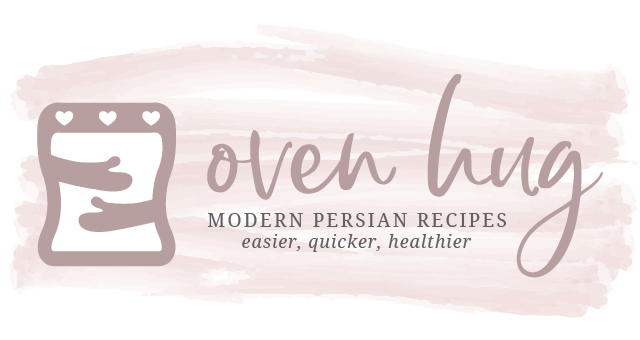
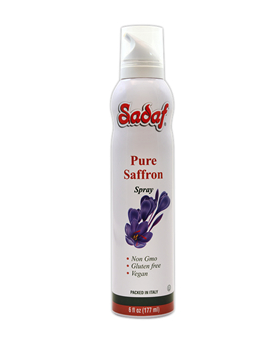

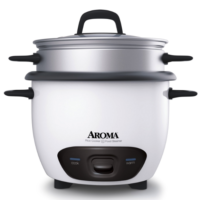
How long should the rice be soaked for? Is overnight too long?
Hi Lisa – soaking is not required…I often skip it myself on a day to day basis. The grandmas in the family would say at least one hour – two or three hours is best. I’ve never soaked it over night. My guess would be that much of the water would be absorbed and so you’d need cut down on the proportions of water if you soak that long. Hope that helps! 🙂
Aha! And, you’ve supplied the answer to my potato question, plus a link to another website for more information and techniques! Thank you!
I love, love potato tah dig! It’s scrumptious. I don’t make it often because to make it right requires a bunch of cooking oil. I try to stick to minimal amounts of oil in my cooking and save that yummy type of tah dig for very special occasions… like when we go to grandma’s house! Let me know how yours turns out 😉
Thank you for this recipe. I got gifted a rice cooker from Iran. I’d I wanted to add saffron, at what point would I do this?
Great question! There are 2 ways you can add saffron to rice cooked in a rice cooker. If you want all the rice to be a light yellow color, you can simply add bloomed saffron (grind and dissolve in hot water) directly into the water of the pot that has the rice in it. If you want the beautiful bright yellow/orange saffron rice on top, you can remove some of the rice from the top of the cooked rice in the pot and add bloomed saffron to it (a small amount of rice, maybe 1/4 or 1/2 cookd) when it is already cooked and stir it in a separate bowl. Then you can gently add it back to the top of the rice. Hope this helps!
I have a Persian rice cooker, but I’m finding it hard not to burn the bottom. Any idea what I’m doing wrong?
Hi Danielle, my guess would be if you are lucky enough to have a good rice cooker that makes a burnt bottom of the pot (it’s a delicacy in Persian cuisine! – called Tahdig, also spelled Tahdeeg), simply add more oil next time. Try doubling the oil in the recipe. Can you send me a picture of what your rice cake looks like when you flip it out of the rice cooker? Maybe also cut down on the cooking time a bit. Good luck! I hope it results in beautiful, delicious rice for you! You can find me on Instagram Oven Hug, Bita Arabian. I’d love to see how it turns out. #ovenhuggers <3
This post makes me really happy because I have an electric cooktop and I have only ever seen Persian rice cooked on a gas stove. My uncle was born in Iran and learned to cook Iranian dishes like a pro when he came here because he missed his mom’s food so much. We have been lucky enough that he has shared his recipes with us and tah-dig is my weakness. Now I need to adapt to an electric cooktop or rice cooker and I see that it is possible. Also, i never hear of a saffron spray! Interesting.
Hi Tarren, I love hearing this story. You are so lucky you learned to learn Persian food from your uncle. Please report back how it goes trying out the new techniques and welcome to the Oven hug community!
Hi, do you recommend buying one of the brands you listed,like Aroma, instead of a brand like Pars which specifically makes tahdig? Do you know if you can use a zojirushi Japanese rice maker using your method above?
Hi there, those are great questions. I have not tried the Pars brand which specifically makes tahdig – sounds wonderful! I have also not tried a Japanese rice maker. I would say experiment with them and let us know how it goes!
I was looking to buy a rice cooker for the sole purpose of making great Tadiq, and clicked on the links you gave. But I don’t see any “high” button on those rice cookers and wonder if there is a mistake. Let me know, please, as I’d like to buy one soon.
Good point Susan. You are right -there is only one button on the ones featured here, this is an older post. I would say peruse Amazon ad read the reviews. The kitchen appliance technology has come a long way! In terms of tahdig, it still comes down to trial and error. With my older cookers I sometimes just push the button down again and again until enough time has passed to get a crispy, golden crust. Good luck and I hope my reply helped. Happy cooking and let me know how it goes! – Bita
It doesn’t say when or how to add the oil. Drip down side? At the end when you add the rag or do you start with it having oil from beginning? Thank you.
Hi! In step 6 of the instructions, it states to add oil in after adding the water. Simply measure and pour it in along with the salt and saffron if you’re using that spice (optional) – easy peasy! At the beginning and before you add the rag or paper towel. The rag or paper towel is the last step. Think of it as wrapping the lid like a gift. Your present will be delicious Persian rice! Hope that answers your question and noosh eh jan.
Hello my rice cooker shuts off automatically. There’s no way to keep it going on high. What do you suggest?
Hi Penny! Darn. That makes it a challenge. I have a few different types. One of my rice cookers I’m able to switch it back on. With another I keep it on the “warming” feature and if I wait long enough I can get a crispy crust. It’s a matter of trial and error for any pot or rice cooker. Keep at it and good luck!!
Hi, in my early 20’s I worked for an Iranian Family as Au Pair. I fell in love with Iranian food and especially with rice with crispy bottom. I especially loved the rice dish which, I hope I remember right, was cooked with chicken, fava beans?, red berries and mint. It was made in a particular rice cooker and my boss used a bunch of margarine,/butter instead of oil. Do you by any chance know which dish this was and have a recipe for me? It would bring back so many wonderful memories. Thank you. Ute
Hi Ute, what special memories. Thank you for sharing. That might be a regional dish. One dish I know has fava beans and dill is called “baghali polo”. Another one that is very delicious is rice with sweet and tart barberries called “zereshk” is called zereshk polo and is typically served with chicken. Perhaps you are remembering these two iconic and delicious Persian dishes? Hope this helps and good luck!!
Hello, I just bought a yum Asia rice cooker with ‘crust’ function for making tahdig! I tried it last night, the tahdig was literally perfect but the rice wasn’t fluffy enough to my liking… I rinsed it first as that’s what I’ve always known our family do, but the actually rice cooker says to put it in dry and my question is, can you do this and make perfect Persian rice? If I should still rinse it, should I put extra water in to make it fluffier? 🤔 merci! X
Hi Michelle! How fun that you got perfect crispy rice! It can be a challenge to get the rice to be fluffy like good Persian rice when using a rice cooker. I’m not familiar with that brand so I would say it is just a process of trial and error. Good luck and keep at it!